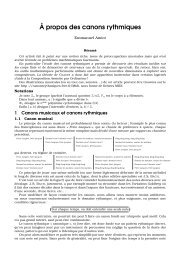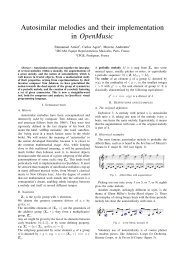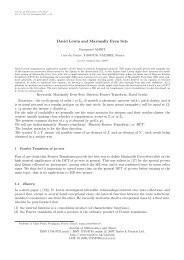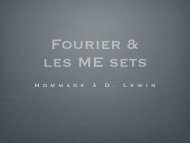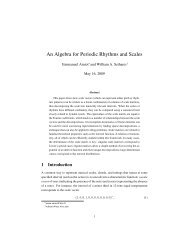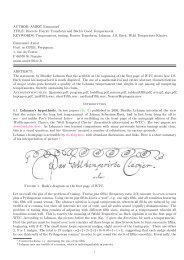Emmanuel Amiot Modèles algébriques et algorithmes pour la ...
Emmanuel Amiot Modèles algébriques et algorithmes pour la ...
Emmanuel Amiot Modèles algébriques et algorithmes pour la ...
Create successful ePaper yourself
Turn your PDF publications into a flip-book with our unique Google optimized e-Paper software.
2.1. Tables. L<strong>et</strong> us begin with a computer program for the computation of MSS on a given T . It is convenient<br />
to put the values of the 12 elements of T in some table:<br />
T = {t0, t1, . . . t11}<br />
To do this, take any table of a temperament in cents and divide by 1200 to g<strong>et</strong> the ai’s. This will be the input<br />
of the function that computes the MSS. Now we loop through the twelve major scales:<br />
For α = 0 to 11, compute the scale Aα and its first Fourier coefficient cα:<br />
<br />
<br />
Aα = (ai = t (ki+α) mod 12)i=0...6 cα = 1<br />
6<br />
e<br />
7<br />
2iπ(ak−k/7)<br />
<br />
<br />
<br />
Lastly, find the minimum and the maximum in those 12 values; subtract the one from the other, and take the<br />
inverse11 of the result:<br />
1<br />
MSS(T ) =<br />
maxα(cα) − minα(cα)<br />
Fig. 4 gives this algorithm in Mathematica R○ , for scales with any number n of notes.<br />
fou1gamme : Modulen Lengthgamme,<br />
N<br />
2 Π gamme 2 Π k<br />
<br />
.Table n , k, 0, n 1<br />
n<br />
<br />
consistencyscale : ModulemajScales, top, bottom,<br />
majScales Tablefou1<br />
scaleSortr 0, 2, 4, 5, 7, 9, 11 1 mod 12 . 0 12,<br />
r, 0, 11;<br />
top maxmajScales; bottom minmajScales;<br />
1<br />
<br />
, top, bottom<br />
top bottom<br />
Figure 4. A program for computing MSS<br />
In Table 5, consecutive fifths are given in cents from the origin; so in program 4, the variable gamme had to be<br />
divided by 1200. All origins (A) have been s<strong>et</strong> to the same value, 0. Of course, different origins can be given<br />
for each tuning, but this is equivalent to some rotation on the circle of notes; and the quantity MSS, being<br />
geom<strong>et</strong>ric in essence, is invariant under such transformations. 12<br />
I selected only a few elements in the extensive family of meantone tunings. The Neidhardt tuning used here is<br />
the 1732 one, as quoted by Lehmann in his answer to Lindley and Ortgies’s acerbic refutation (see [9]). Lindley’s<br />
tunings are tabu<strong>la</strong>ted from the same source: the first two are built respectively with sevenths of Pythagorean<br />
and syntonic comma, and the <strong>la</strong>st is the tuning used in the Michaelstein conference (this one found favor with<br />
Lehman). Simi<strong>la</strong>rly I added the Sparschuh tuning and the previous Lehman proposition (dated 1994) as possible<br />
comp<strong>et</strong>itors, other interpr<strong>et</strong>ations of the scribble being of course of particu<strong>la</strong>r interest.<br />
I hope that through the process of chain-quotation, the exact values of these tunings have been preserved. As<br />
the computations have been carried through the professional software Mathematica R○ , with 64 bit arithm<strong>et</strong>ic,<br />
we can hope to be rid of the rounding errors that blemished several controversies, and that resulted from<br />
incompatible unit conventions and inadequate software (Excel R○ ).<br />
It is quite clear on these values that LT achieves by far the best value of MSS, except for Werckmeister IV 13<br />
which reaches almost equal value. It is interesting to see which c<strong>la</strong>ssical tunings figure well in this table:<br />
Kirnberger’s are in good stand, so is Valloti, but it is a little surprising that the Pythagorean tuning supersedes<br />
11In order to facilitate comparison.<br />
12 Incidentally, it is also invariant under inversion (which amounts to reversing the lists), as the inverse of any major scale is also<br />
a major scale.<br />
13 I wonder wh<strong>et</strong>her this temperament ever had practical importance – who ever managed to tune a 196/139 interval by ear ?<br />
k=0<br />
7




